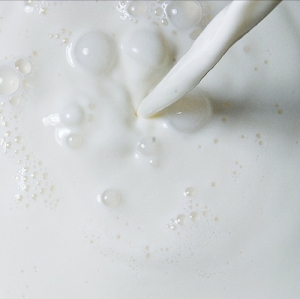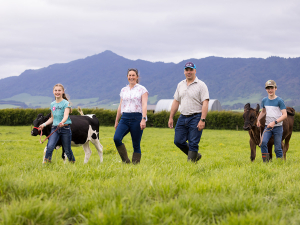CHINA'S DEMAND for dairy imports is set to grow for at least the next two years, as its local milk production struggles under structural change in the supply chain, a new industry report has found.
In the report, China's Raw Milk Supply: Still Dreaming of a White River, international food and agribusiness banking specialist Rabobank says China – already clearly the world's largest dairy importer – is expected to be one of the key drivers of global dairy consumption growth over the next decade.
And – despite the fast pace of development in China's own dairy farm systems – imported dairy products and ingredients will continue to play an increasing role in fulfilling Chinese market requirements, with local production growth currently stalled.
Report co-author, Rabobank director of dairy research New Zealand & Asia Hayley Moynihan says China's milk supply chain is rapidly changing, with the development of large-scale dairy farms accelerating since 2008, in the wake of the 'melamine crisis' (when melamine-contaminated locally-produced milk and infant formula negatively affected the health of some 300,000 people and resulted in the deaths of a number of infants).
At the same time, 'backyard' dairy farming has declined, primarily due to inconsistent milk quality and regulatory pressures.
"Milk production in China is struggling to grow as a result of small-scale farmers exiting the industry and large-scale farms still being under development," Moynihan says. "And it is likely to be at least two to three years before the pace of large-scale dairy farm expansion in China outweighs the current contraction in 'backyard' sources and leads to a reduction in import growth."
Moynihan says slowed growth in milk production in China has already seen the country's reliance on dairy imports growing by between 20 and 30% per annum in the past two years. China is now expected to import almost 20% of its milk products to satisfy current domestic demand.
"The surge in Chinese buying in a shrinking global supply pool of dairy has squeezed out many other buyers and held dairy prices at high levels," Moynihan says.
"Even when that rate of growth in imports slows, China will remain a major consumer of global dairy exports."
Dairying in China – moving out of 'the backyard'
China's appetite for milk and dairy products has been rapidly accelerating in recent years, as its consumers become increasingly affluent and adopt a more westernised diet.
Rabobank's Shanghai-based senior dairy analyst Sandy Chen, who co-authored the report, says while just over 80 per cent of the Chinese dairy market is still supplied by domestic milk production, this domestic supply remains under-developed with about 60 per cent originating from small-scale dairy farmers operating with less than 100 cows per farm.
"The cows are typically raised in backyards and fed on forage grown on-farm, however the quality of milk is very inconsistent," Mr Chen says.
In addition, milk from small producers is 'pooled' at collection stations that act as middle men with processors, providing infrastructure, organising logistics and aggregating milk volumes. "This structure has also heightened food safety risks along the supply chain," Mr Chen says.
In the aftermath of the melamine crisis, however, the Chinese government has taken steps to resolve supply chain issues and strengthen raw milk quality control. Chief among these has been the introduction of a licensing and review system for milk collection, whose enforcement has been discouraging the collection of raw milk with poor quality consistency, especially from backyard operators.
"This difficulty, combined with the production costs of feed and labour surging faster than raw milk price increases, has forced many backyard farmers out of the market," Mr Chen says.
Rise of large scale farms
At the opposite end of the spectrum, the Rabobank report says, the focus on milk quality in China post-2008 has favoured the rise of large-scale dairy farms, accelerating their rate of growth.
"The share of production of large-scale farms, with more than 500 cows, grew rapidly from 17 per cent of total milk production in 2008 to 27 per cent in 2011," Mr Chen says.
The business models of large-scale dairy farms vary significantly from the backyard operators, with the larger players wholly responsible for their product as the milk produced is sold directly to processors. Media Release October 14, 2013
3
However, Mr Chen says, the supply from newly-established, large, organised dairy farms is still at an early ramp-up stage and has been unable to fully offset the reduction in supply from the exit of backyard farms.
"It is this situation which is resulting in an expanding gap between the annual supply and demand for dairy in China – from below five per cent in the pre-melamine crisis years to an estimated 18 per cent as of 2013, which is being filled by imported product," he says.
Export opportunities
For exporters to China, Rabobank's Hayley Moynihan says, the window for trade opportunity is likely to remain wide open for some time.
"And the willingness of Chinese commodity buyers to pay higher than historical average prices to source product on the world market is likely to persist, as long as this remains competitive when compared with sourcing locally from high quality milk," she says.
However, the Rabobank report warns, demand growth is expected to prompt Chinese buyers to seek our more diverse import options, instead of continuing to rely on one or two key product origins (such as New Zealand).
"And it is important to recognise that the tide of local milk production will eventually rise over time and compete more strongly with imported product, albeit at a relatively high price point due to local production costs," Ms Moynihan says.

















